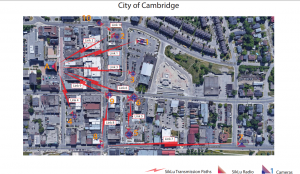Smart cities and video security – Using high-band millimetre wave networks for fast deployment and HD quality

David Sumi
Smart City applications and services seem to be expanding rapidly – smart parking, smart street lighting, climate monitoring, transportation and traffic management are only a few of the categories. One application that is growing in importance and popularity is that of video security. And within that realm, HD quality video has rapidly shifted in the eyes of city managers from a luxury to almost a “bare minimum” requirement for a variety of reasons, such as standard surveillance, crowd management, facial recognition and policing.
And in order to support an HD video network, a combination of fibre optic lines and high-bandwidth wireless networking is required. To meet that need, cities are increasingly eyeing the relatively uncongested and inexpensive “high-band” millimetre wave frequencies at 60 and 70/80 GHz, what are known as the E- and V-bands. One recent example involves the City of Cambridge in Ontario, Canada.
The city had existing fibre connections connecting several municipal buildings and continues to deploy more where it makes economic sense. Fibre is used to connect fire stations to City Hall for example. However, this particular application, outdoor video security, was one that needed more flexibility to accommodate the necessary camera locations. Most parking lots, Intersections and pedestrian walkways do not have a fibre POP (“point of presence”) nearby. This meant the answer would almost certainly have to be a wireless solution.
The proposed video security network also had several additional requirements. It needed to be flexible when it came to expanding the video security coverage, it had to be secure and it also had to have enough capacity that it could support additional high bandwidth non-security related applications, such as the deployment of Public Wi-Fi. Essentially, this meant that the wireless network would need a backhaul capability in the order of “Gigabits per second” and be able to expand or reconfigure as needed without additional “truck rolls.”
The City’s network management and security consultant firm, Alliance Security Systems, investigated 5 GHz solutions as well as 60 GHz and recommended a 60 GHz-based radio network for current and future requirements. The network, which began work in June 2019 and is ongoing, currently has more than 20 point-to-point connections ranging from 100 Mbps to 1Gbps, link ranges of up to 1 kilometre and – perhaps most importantly – an immunity to other sources of radio interference. For instance, 5 GHz systems are subject to an ever-increasing Wi-Fi “noise floor.” Further, radio equipment in the 60 GHz band can use small antennas that fit easily on street light poles and other “street furniture.”

Phase 1 of the program supported ten multi-lens camera deployments, and the network design had six 1-Gbps V-Band radios collocated at the city Clock Tower. This dense colocation was made possible by the very narrow radio beams inherent to 60 GHz systems and the abundant spectrum (14 GHz ) available in that band.
The City also operates the Phase 1 network to provide access to police as requested for specific incidents or investigations. Since the installation of the video security network, a car theft ring was broken up and there has been a noticeable reduction in crime.
Tom Hackett of Alliance Security Systems recently commented, “By utiliing the point to point technology in such a way where we co-locate the head end, we end up approaching a cumulative speed of over 10 Gbps per second once Phase 2 is commissioned. That’s just an astounding wireless speed in today’s world.”
Phase 2 will add seven new cameras and will be supported by additional V-Band radios that will supply 1 Gbits of capacity,
To conclude, hosting Smart City video applications on a fibre network affords both high speeds and high reliability, but it cannot be deployed “everywhere” – wireless systems are needed to fill the gaps. And when it comes to wireless, “sub 6” GHz technology for video surveillance connectivity can provide an affordable and flexible solution, but it struggles to deliver the capacity and can experience other problems such as unreliable connectivity, poor latency, and interference from other wireless networks. Therefore, high-band millimetre wave systems are increasingly viewed as a preferred option for their fast installation times, high speed and high reliability.
The author is David Sumi
Comment on this article below or via Twitter @IoTGN
